The Renault Caravelle was a pretty body in search of some more power in the United States. And, I should add, a pretty rusty body in most cases. However, this 1963 model seems to have escaped a lot of the rot and is now for sale here on craigslist in Hollister, California for $4,900. Thanks to Pat L. for this great find!
If you’re not familiar with the Caravelle, it’s one of several rear-engined “sporty” cars that were produced by European manufacturers in the 1950’s and 1960’s by putting a pretty body on a relatively low-powered sedan platform. Other examples include the Fiat 850 and Volkswagen Karmann-Ghia. This particular pretty body was designed by Pietro Frua, who had started his own styling studio in 1937 but sold it to Ghia in 1957. One of his first tasks as the new “Frua Styling Chief” at Ghia was to design the little Renault.
The Caravelle (also called the Floride in some markets, more about that in a moment) was based on the Dauphine platform, in itself a very successful car for Renault. When I was researching this post I found out that the inspiration for the Caravelle/Floride came from a trip the Renault managing director Pierre Dreyfus and director of research Fernand Picard took to Florida at the request of the largest Renault dealer there. The end result was recognition of the need for a sporty convertible!
Getting back to this car, it really does look solid, although the seller does say there is “minimal floor pan rust.” Even the interior looks great!
While it doesn’t currently run, the seller tells us the gearbox and clutch are known to be good. They also state that this is the original paint and that the steel hardtop can be removed (they came both in coupes and convertibles) although the soft top needs to be replaced. I think this car could be a lot of fun, albeit rather slow fun with fewer than 60 cubic inches! What do you think?
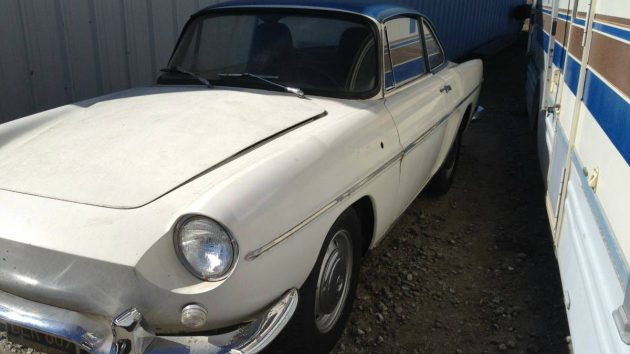
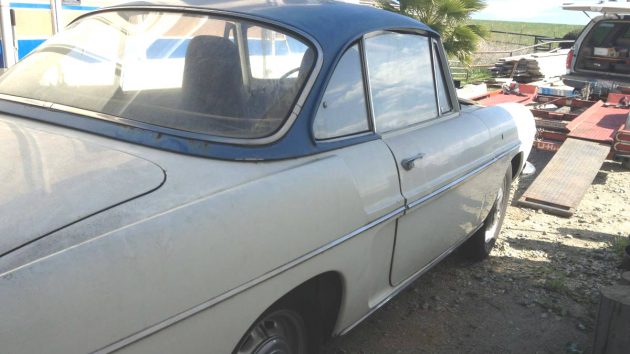
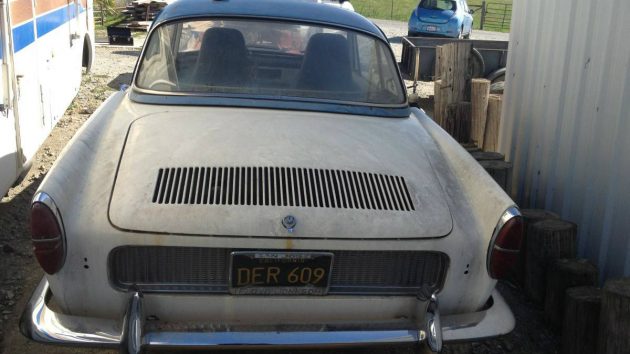
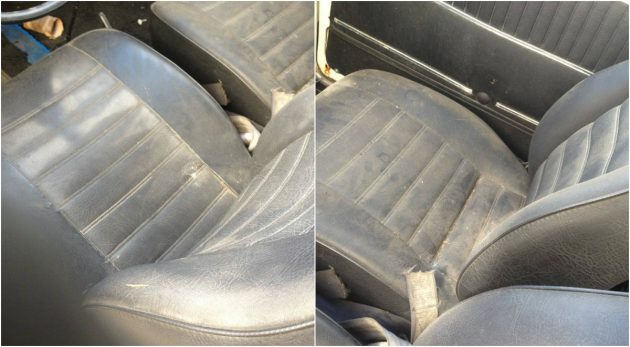
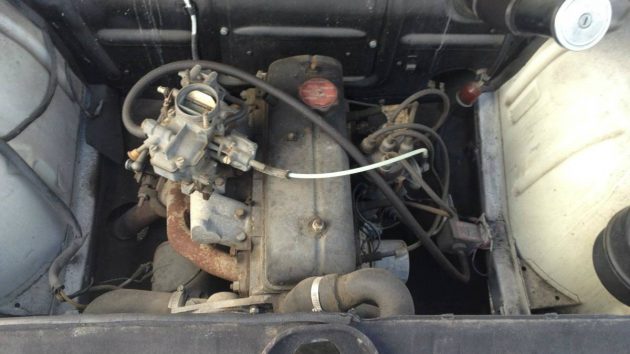


For such simple cars they are a great deal of fun, just not quick fun. I have never seen if a larger motor can be substituted for the original engine but almost any of the newer engines from Renault would be a good idea. If you do upgrade the brakes and cooling system as well. That will be simpler than you might think. Besides rust the other critical thing is for an amazingly simple electrical system it is a terrible system.
My friends that have owned these have all had to nearly totally rewire and re-engineer the electrical systems. For a Spring, Summer and Fall grocery getter, putter around town these are perfect and useful. To see how simple something can get besides a VW, or Fiat these are the French take on the same idea.
They are also surprisingly beautiful when in good condition. Given the condition and what you want to do with it, could be a great father son project (or daughter) that would take a year to two of weekends to complete.
You would then have the only one around for miles and a son or daughter that had real respect for what they are driving. Something that they would value far higher than any current used car they might end up with. What that is worth is something only the right buyer can know.
My old man had one of these. It was one of the few foreign cars my old man would have in his driveway. I was pretty young, but distinctly remember not being able to open both doors at the same time. Got to be the only one in the country to look like this.
What Bruce said, especially how gorgeous these cars look when in good condition.
Think of it as Renault’s answer to the Karmann Ghia.
The French could never answer anything or anyone German…..these are a lovely design searching for a real heart. (The tin Man?) I understand the comparison to a Ghia but like the French army……just couldn’t get there. The basic purpose of a vehicle to transportation, a nice design is wonderful but if you can’t keep it running it is destine for the scrap yard….exactly where most of these wound up. I am sure they were adaquate on the 20MPH roads of Paris on short city runs but totally inadequate for North American roads or use.
With updated brakes and cooling a 1600cc twin cam Abarth would work for me.
An A-110 Alpine driveline would virtually bolt right in and would really transform the li’l Renault.
For both Mr. Jo6pac and Bedouin something as simple as a renault r-17 or 18 engine would make a huge difference and should bolt right in as almost all the renault engines has very similar blocks and transmission sizes.
Most certainly the breaks could and should be exchanged as well as adding a 3 core radiator for cooling. As for the structural issue I am certain some well placed under floor reinforcing could make a world of difference.
This is one of those cars I wish somebody would make molds of so they could become kit cars using the advanced technology of today that would truly make these designs wonderful to drive. Having driven a real 356 and some of the better kits I can assure you the kits are much better cars in almost all respects.
Or a real drivetrain like a 356 SC engine/trans, with enough money applied you could make it a Ferrari……….
I had two ’67s with the nicer round gauge dash – and they had the reinforced chassis which I believe was introduced in either ’63 or ’65. I recommend anyone who wants to buy this one to pin down when the reinforcements went in, as before that change these cars had a serious problem of folding up when the doors were opened! I know – I first bought a nice looking ’67 in Michigan, not realizing some PO had filled the large sill rust holes with FOAM urethane and painted them to match! When I checked out the door-shutting issues I found the pillar latches beaten to pieces as the doors sagged due to the flexible flyer chassis, and the doors did a fair bit of the work keeping the body from flexing! The engine/trans ran great and it had the later higher rear edge removable hardtop, as did my second California car, which was much stronger due to lack of rust.
Altho I’ve since sold both cars – I couldn’t get into them, being 6′ 4″, but still found them interesting, I appreciated the fact that they had 4 wheel discs starting around 1963 – way ahead of many brands. But strangely the calipers had central pins with some sort of retracting mechanism which made them more complex to rebuild than anything that came after them – seems the Europeans were cautious about going to discs and did a bit of experimentation before finding out they didn’t have to be so fussy in their design – I could’ve throw away the center pins and just plugged the holes in the caliper ends and they would’ve been easier to service! Lastly, I found that on grassy surfaces I had to rev the engine pretty high and slip the clutch a lot or the engine would bog down and stall due to a very light flywheel. The engines put out very little torque. Since then I’ve come to appreciate Panhard engines of only two cyls/850 ccs and yet bags of torque.
I used to own Renault Dauphines as you could buy them for $50. to $100. back in the late 60’s to early 70’s. I also found a 1960’s Renault 4CV that had been sitting in the seller’s backyard in Chico Ca. for 8 years. We added gas, oil and jumped it from another vehicle I ended up driving this little rust-free car for about 8-years. My girlfriend’s dad at the time had a Renault Caravelle he would let us take out occasionally. It drove just like a Dauphine with the top down. I definitely had a love affair with these little French Cars back in the day!
The complicated disk brakes were a French thing. Jaguar went from all drum to all disk beginning in the late 1950’s on some models. They were dead simple. We had to rebuild many calipers due to corrosion in the Rust Belt. Volvos were also simple.
Mom had one back in 1964-65 . 2 kids in the back (4&6 years old), one beside her (8 years old) and off we’d go to the grocery store . Definitely not the most practical family car but she liked it.
It’s cool ! Very unusual. I like it !
The R-8 Gordini had a good engine that would be a perfect match for this.
http://bringatrailer.com/wp-content/plugins/PostviaEmail/images/1966_Renault_R8_Gordini_For_Sale_Motor_0_resize.jpg
My boss used to say that they made Renaults out of Prince Albert Tobacco cans. Loved their styling and I seem to remember lots of Daupines around.
That is a Renault that I wouldn’t turn my nose up on
My father had a 1961 Caravelle with a very spirited 850cc engine in it. It was optioned with a Gourdini engine which had very respectable torque. The downside to driving it was the butter churn shifter that required a lot of stirring to find the right gear. I had a chance to restore it but although appearing like a solid example, when I got into it the frame rust was so extensive around the front suspension that I feared the nose of the car would collapse. It was too extensive for my a amature abilities to restore. The seats in this one are not orrigional and really look out of place. If someone wanted modern seats it should have had some low backed seats with headrests. Just my opinion.